It is a lucrative business decision to create an e-Learning website where people can learn new subjects/skills remotely at a lower cost. These platforms always had the potential to survive in the market even before the COVID pandemic. But with the turn that the global economy took post-pandemic, these have now become widely preferred instead of in-person lectures by many learners.
According to the Coursera Reports 2022 Q1, Coursera now has more than 100 million registered learners. And the popularity of platforms like Coursera, Udemy, and edX will only increase as more and more people recognize the convenience of e-learning platforms.
Many established educational institutions have also begun recognizing the certifications of various e-learning courses, which has solidified the credibility of these platforms among many new learners and has accelerated the e-learning market growth.
Becoming a part of such a market has many advantages for you. But to get on those benefits, you would need to create an e-learning website that provides free and paid online courses to help learners.
10 Steps to Build an E-learning Website
The best way to build e-learning websites is by planning every little aspect of the process. It would help you meet market requirements and prevent any unexpected/expensive results.
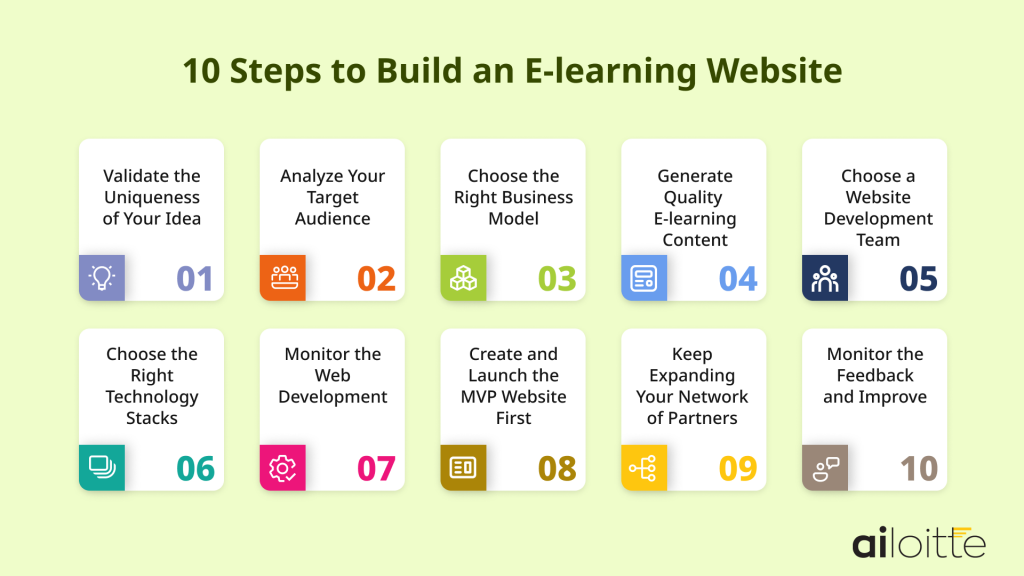
Validate the Uniqueness of Your Idea
The number of e-learning websites is growing in the market every day, so you will need something different and unique to stand out from the competition.
You can talk to various educational institutions or the users of popular e-learning platforms to conduct thorough market research. Talking to business analysts and marketing strategists will also help get better insights into the requirements of current learners on the e-learning platforms. Lastly, it will help identify factors that can make your e-learning website unique compared to others.
Ailoitte Tip: Make sure you validate the uniqueness of your idea in the pre-development stage. It will ensure that your e-learning platform development process heads in the right direction.
Analyze Your Target Audience
Categorize your primary and potential target audience. Knowing your audience well is the first step to learning how to create an online learning platform that stands out. It will help you build e-learning websites that can attract a huge customer base.
Choose a niche for your e-learning website that is convenient to the target audience and provides a variety that could attract an entirely new target audience. For example, if you make an e-learning platform for learning corporate-level courses, you can provide learning like data science, digital marketing, and Python in multiple languages. Before you get into the design and development stage, figure out the answer to these questions:
- Who is your primary target audience?
- What are current e-learning market trends?
- How can you motivate users to keep using your website after course completion?
- Do you want your e-learning platform to be global?
- How to create an online learning platform with multilingual products/services?
- Which online courses are most popular now?
- Which online courses have the potential to become popular in the coming years?
Some examples are data science and digital marketing courses.
- What are the standard age groups and demographic of your target audience?
Use this information to choose the most strategically lucrative direction for your e-learning platform development process.
Choose the Right Business Model
Analyze your business requirements and resources to develop an e-learning platform with the best business model.
Night School Model
This model includes various courses where learners get pay-per-access to them. Meaning, every new course will require payment.
For example, a person can pay for the Spanish learning course and move on from your website after course completion. It’s a good business model to start generating revenue and examine the early performance of your e-learning website.
Courses under this e-learning business model have a fixed framework that includes learning modules, assessments, quizzes, and examinations to test the learner. It’s crucial to note that the night school model is only suitable for learners who want to learn a specific subject or skill.
What we recommend is providing many courses to attract more learners and make this model work. If not, the learners might not use your e-learning website again after course completion.
Academy Model
The academy business model includes an all-in-one subscription-based online school where you provide multiple videos, audio files, written courses, and lessons in different learning tools.
This learning model can include personal instructions, live tests, and a recognized grading system. For example, a learner can get marketing tools and live advice from a marketing expert if they choose a digital marketing course. And learners can find out everything about a particular subject like Psychology with practical examples and virtual guidance. A subscription to such a platform provides learners access to all the knowledge as long as they keep paying the subscription fee after expiry.
Combined Model
A combined model includes both the night school and the academy model. The learners can choose to get subscriptions or just one-time access to particular courses. This model is perfect to create online learning websites that can attract different types of learners.
Ultimately, you will need to choose the best model for your business from these three by comparing their suitability.
Generate Quality E-learning Content
You should develop an educational strategy and divide it down into lessons for each online learning course. The next step is to begin generating online learning content and video lessons. Consider having courses that are both instructive and brief so that learners do not get bored. Each lesson in your course must include quizzes or tests, and provide additional information and resources to explain the subjects effectively to learners.
A key thing can be to ensure that the most skilled and qualified educators deliver the content on your website. You can create a partnership with various educational institutions and teachers for that. Choosing the most qualified educators will also help you build a credible image for your e-learning website.
Top 17 Profitable Mobile App ideas
Choose a Website Development Team
Finalizing an experienced team is the best way to approach website development. You can either hire an in-house team or outsource. However, hiring in-house staff can become a problem for your project as the in-house teams will require office space with all the right facilities – which would cost a lot more money than you earn.
Thus, outsourcing is the way to go if you want to go easy on your budget. Now, when it comes to outsourcing, you have three reliable options.
Onshore Developers
You can hire web developers from your own country as it will make monitoring and feedback implementations more effective and frequent.
Onshore development companies also know how to create e-learning websites for a local target audience. It can be helpful for a new e-learning platform as it would help them attract the right customer base sooner.
In this model, you will not have significant cultural differences or language barriers with onshore developers. However, it can be an expensive option if you are from the USA, United Kingdom, or Canada.
Nearshore Developers
You can hire an e-learning platform development company from a nearby country. For example, a US-based business can hire developers from Canada. It is one of the great ways to find developers that may go easy on your project budget. Moreover, like hiring onshore developers, in this model too, visiting the workspace of the developers is easy and there is little to no cultural difference or language barrier.
Offshore Developers
Outsourcing educational platform development to offshore developers is the right option if you have a tight project budget with many requirements. It is now a widely chosen option for many development projects.
According to Statista, The global market spending on outsourcing and shared services (OSS) may reach $971 billion by 2023 compared to $688 billion in 2018.
Offshore developers come with an in-depth idea about the international market. And they know how to create an e-learning website that meets the requirements of a global user base. You can outsource the e-learning website development to an established web development company from countries like India and Ukraine.
These countries have highly skilled developers that will charge a lot less for the same set of tasks. However, it is crucial to note here that the developers you choose must have experience or some understanding of an e-learning website. Analyze their portfolios to make sure they are suitable for your requirements.
Choose the Right Technology Stacks
Choosing the right tech stack to create an effective eLearning platform can be challenging. Hiring the best web developers will help you do this with ease.
Here are tech stacks you may need for your E-learning Website:
- JavaScript
- Bootstrap
- CSS3
- Angular
- React.JS
- Node.JS
- Express
- MySQL
- MongoDB
- PayPal & Stripe
- Cloudflare
- AWS
- React Native
- Laravel
Monitor the Web Development
Explain your primary e-learning website goals to the developers. It will help them work towards that final outcome better. Keep a close eye on the platform development process to identify any flaws in the direction as it will always be better to know about these flaws during the process than after.
Next, do research on the market about the requirements of similar websites. Talk to UI/UX designers, frontend developers, backend developers, and other team members regularly to learn about the progress. It will help you steer the development process in the most lucrative direction.
Lastly, user experience is one of the USPs of an e-learning website and any bugs or crashes in your website could ruin that experience. Thus, monitor the e-learning website developers, their methods, and the testing process to ensure the final product meets all the requirements.
Create and Launch the MVP Website First
A minimum viable product for your e-learning website is the smart way to approach the project in a competitive market, as it will be cost-effective and will help you get early feedback from prospective customers. The USP of an MVP lies in the fact that it will only have core features required to find, provide, access, and study the courses/subjects.
You will understand whether your e-learning platform has the potential to survive in the market once you launch the version. Creating an MVP of an e-learning website is a quick way to start generating revenue and figuring out the requirements of your final/advanced e-learning website.
Keep Expanding Your Network of Partners
The credibility of your e-learning website will be the most crucial factor behind its success.
Maintain that credibility by frequently collaborating with educational institutions like universities, colleges, high schools, and even libraries. You can start your own e-learning business with ease if you have such partners as your e-learning website will seem more trustworthy if you have many skilled and experienced educators or their lessons/case studies/courses on your website. Keep finding new institutions and educators to present on your website.
Monitor the Feedback and Improve
Dealing with bugs and updating the website features is necessary after the launch. It also impacts the feedback you receive from early users. A way to monitor this can be to get answers to these questions.
- Which section do they spend the most time on?
- Which course is popular among the target audience?
- Which courses/subjects are least popular?
- Which website section is least visited?
Compile all this data to implement the changes required in your e-learning website. Make sure you monitor user feedback and behavior regularly.
You must also keep in mind the benefits of Coursera and Udemy to know what you have to provide and what you can do better. It will help you start an e-learning business that can grow and survive in the market.
Reasons Behind the Success of Coursera and Udemy

Coursera partners with universities, professors, and various educational institutions to provide lectures and courses. It is a platform where professional educators can increase their digital reach.
All of these courses are available with a subscription. Coursera provides pre-recorded videos of lectures from many global academic institutions, while for new instructors, it provides tools for presentations, live discussions, assignments, quizzes, and reading. Coursera is the primary choice of many students.
Here are some benefits of using Coursera:
- Global Reach and Academic Collaboration
- Recognized Teachers and Educational Institutions
- Variety of Courses/Certifications
- Peer-guided and Reviewed Projects
- Practical Assignments
- University Degree Courses
- Access to Unlimited Knowledge
- User-friendly Website/App
- Multiple Payment Options
- Flexible Study Schedule
Udemy, on the other hand, partners with teachers/instructors to create, organize, and provide its products and services. It offers courses about popular subjects like entrepreneurship, marketing, development, communication, personal development, languages, IT & software, finance, and e-commerce.
Here are some benefits of using Udemy:
- Fairly Priced Courses
- Wide Selection of Instructors
- Wide Variety of Courses/Categories
- User-friendly Website & App
- Automated Course Progress Tracking & Storage
- Certificates after Course Completion
- Pay-per-course Business Model
- Lifetime access to purchased Courses
- Courses with Chat Rooms
- Custom/Flexible Learning Schedule
Types of E-learning Platforms
Choosing the best type of e-learning platform according to your budget, resources, and business requirements becomes easier with the assistance of an e-learning development company. However, let us try and make it easy for you by giving a snapshot view of the different options.
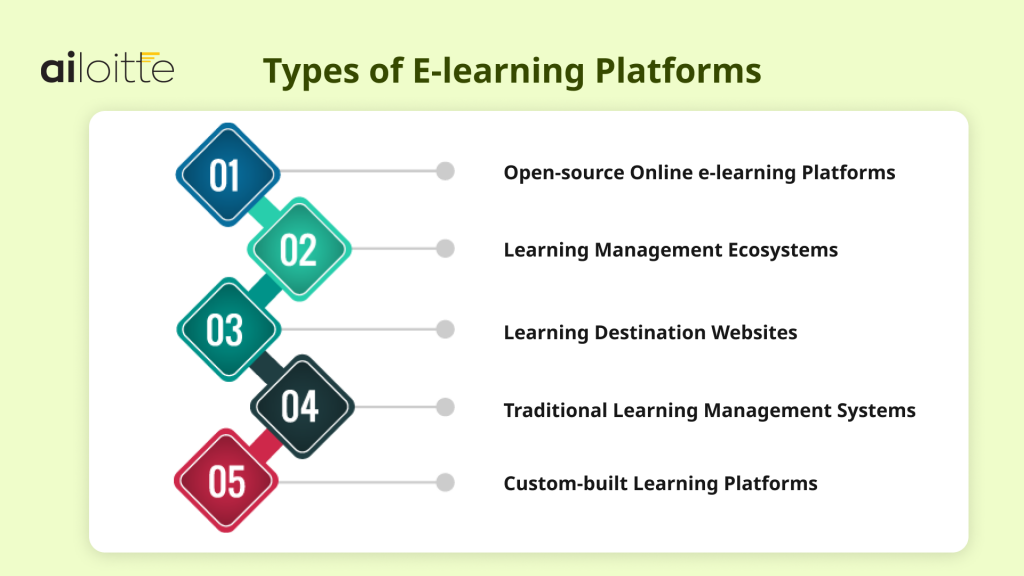
Open-source Online e-learning Platforms
Open-source websites have customizable functionality and come with an e-learning website design that users can modify according to their liking. These platforms are ready-made online learning solutions with both free and paid tiers. You can use this platform to build your instructor profile/post instructional materials and accept money from students with online payment gateways like PayPal and Stripe.
Moodle, Litmos, and BrainCert are some examples of open-source e-learning platforms.
Learning Management Ecosystems
Learning Management Ecosystems is a framework that uses and combines the best-in-class point solutions into a single platform.
Educational software, assessment, e-commerce tools, e-learning engines, and content management tools are all part of such systems housed on a single platform. These learning ecosystems are often created with a bespoke frontend to provide the idea of a unified system.
Additionally, a powerful backend server and frequent monitoring are required to create an online learning platform like this.
Adobe eLearning Suite (Adobe eLearning Suite) is an example of a Learning Management Ecosystem.
Learning Destination Websites
Learning destination sites are websites that combine a variety of online courses from many sources into one location. These e-learning websites function similarly to online retailers. There can be a redirect link or an all-in-one course accessible on the internet. Users may choose the course they want to take and gain access to it.
The usual approach to working with destination sites is to create training materials that utilize the site’s capabilities and submit them. The site includes capabilities for handling money transactions and customizing features for content creators. The most advanced e-learning platforms tend to fall within this category.
Examples of these platforms are Udemy, Coursera, and eDX.
Traditional Learning Management Systems
Choose TLMS if you wish to establish an e-learning website with tools like producing reports, tracking the development of students, and developing profiles, etc. for content providers.
In this platform type, the instructors and content creators have the authority to develop courses, manage study materials, report progress and performance, and handle various administrative tasks. These platforms follow a one-to-one approach with educators via online classes where they offer learners the option to choose their courses and teachers according to their needs with interaction methods like gamification, quizzes, and progress tracking.
Custom-built Learning Platforms
This one offers a fully customized solution to create an online learning platform based only on your company’s requirements. With this model, you are able to create an e-learning platform from the ground up with the help of software developers with all the features your educational institution requires. Moreover, you will be able to integrate online courses from partner universities, charge students fees without intermediaries, run adverts, and build your platform over time.
A well-known example of this framework is Harvard Business School (HBS).
Must-have Features of an E-learning Website
An e-learning platform needs some core features to function well and make the experience convenient for learners.
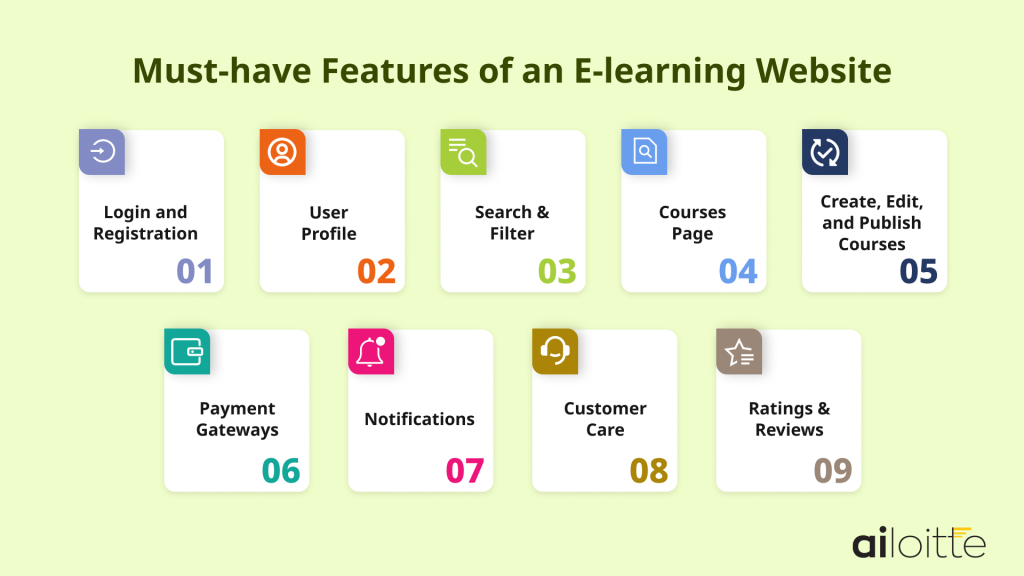
1. Login and Registration
For secure access to the website, the login and registration feature is necessary. Registration and login through Gmail and social media accounts like Facebook and Twitter will make things convenient for users.
2. User Profile
Learner’s profiles with names, profile pictures, and dashboards for ongoing, finished, and saved courses will be convenient for the students. On the other hand, the instructor profile page could include sections for their skills, degrees, and dashboards for their published courses.
3. Search & Filter
Your website must have an innovative search and filter feature to help users find courses, teachers, and available learning tools. You can also categorize your content according to fields like chemistry, marketing, or psychology for users to easily browse through your content and buy the courses.
4. Courses Page
Every course must have a page of its own with detailed descriptions like the number of lessons and overall learning duration, and instructor’s details. The page should also display the course/subscription price and buy option.
5. Create, Edit, and Publish Courses
Professors/educational institutions can use this feature to create and publish courses with ease. They must also be given the ability to edit their published course content when necessary.
6. Payment Gateways
Your website should provide multiple payment methods like cards, PayPal, and Stripe to make payments easier for users.
7. Notifications
The notification feature will remind learners about new arrivals, daily course recommendations, and unfinished courses/subjects. It will also tell learners to continue studying at a specific time of the day.
8. Customer Care
Customer care support on your website will solve the problems/doubts users have. Having automated, AI-powered support will make addressing issues more real-time for your users.
9. Ratings & Reviews
Having ratings and review features helps improve the credibility of your e-learning platforms. It will help the learners choose the best instructor while providing you with feedback that you can use to improve the various functionalities of your website.
Tips to Attract Learners to Your E-learning Website
Knowing what you have to provide on your e-learning website to make an impression on the target audience will help you keep up with the competition and emerge as the EdTech space’s leader.
Here are some things you can provide to make your website better:
1. Unlimited Courses
Collaborate and partner with as many professors/universities as you can. It will help you add more courses and lectures to your e-learning website – making it beneficial for learners who would get everything they need in one place.
2. Cost-effective Solutions
Make sure the course or subscription fee on your e-learning website is affordable or low. The users will avoid your website if they have to pay the same amount for lectures/courses online as they pay at universities, schools, and colleges.
3. Rewards and Quizzes
Provide rewards like ranks and badges to learners whenever they complete a particular chapter to motivate them. Quizzes after every chapter also make learning fun for users.
4. Regular Assessments
Learners should be able to track their progress and improve on it over time. An assessment of their progress by analyzing test and quiz performances will prove helpful.
5. Course Certifications
You can provide certifications for learners who complete courses on your website. Certifications recognized by universities and companies will attract more users to your website.
6. User-centric Courses
Know which subjects and courses your target audience is more interested in or needs at different times. For example, a chemistry student will need different courses, learning tools, and lectures every semester.
Do the required research, know the target audience and e-learning industry trends, and provide those subjects, lectures, and courses on your website at affordable prices.
7. Multilingual Platform
A multilingual website will help improve the convenience of international students/users and will bring a large customer base to your e-learning website. A great starting point for this would be to choose a development team that knows how to start an online education website with multilingual solutions.
8. Live Audio and Video Calls
You can improve the learning experience by providing video and audio call features. It will help students and teachers discuss the lessons/subjects clearly and conveniently.
How Much Does it Cost to Develop an E-learning Website?
The cost to develop an e-learning website depends on your website’s complexity, features and e-learning platform design requirements, content, and developer rates.
However, note that educational website development with advanced features is more expensive than MVP website development.
| Cost Estimation to Develop an E-learning Website | |
| MVP Development | $15,000 to $20,000 |
| Standard Development | $30,000 to $40,000 |
| Advanced Development | $45,000 to $60,000 |
An e-learning website development costs may even reach $80,000 and more with complex features and content. You will need to analyze all the requirements to know the exact cost estimation to develop your e-learning website.
User Journey Map in Software Development
Monetization Models for eLearning Platforms
Implement these monetization models in your website to begin generating revenue from your users.
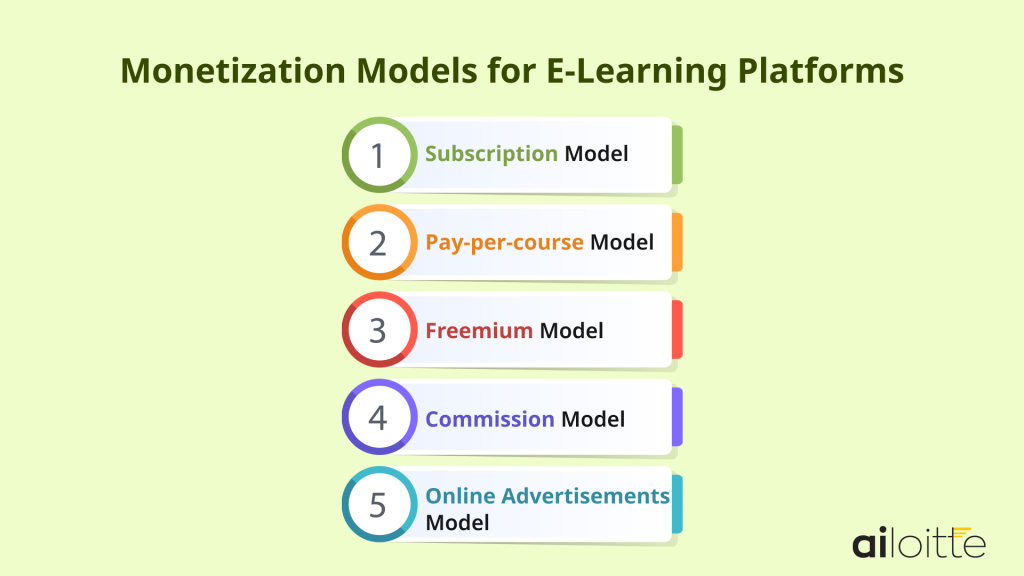
Subscription Model
This model includes charging a subscription fee every month or every few months to get access to all courses and lectures. The learners will pay the fee after the course expiry to retain access to the courses.
Pay-per-course Model
Building an online education business with this model requires the learners to pay for the course/lecture they want. They get lifetime access to that content after paying once. Udemy is a successful example of a pay-per-course model.
Freemium Model
The freemium model is the best option for a new e-learning website. It involves a practice where you offer courses and lectures for free but require payment for the certification.
Commission Model
The commission model includes a service charge for every payment made by learners. The charges may also apply to payments received by professors, teachers, instructors, or educational institutions.
Online Advertisements Model
Displaying advertisements relevant to the niche of your e-learning website is another great way to generate revenue.
12 Ways ChatGPT is Changing the Business
Final Note
Building e-learning websites is a good business choice as their demand is increasing and pandemic-proof. More and more learners will continue choosing the remote and online convenience of e-learning platforms.
However, you can generate revenue and fame only if you focus on improving the learning and teaching experience for everyone. All you need is the right development strategy and a capable team to create your own e-learning website. Something that industry experts like Ailoitte can help you with.
Whether you are trying to create an e-learning website/app for kids, university students, or anyone looking to learn something new, we can make it happen by analyzing business and market requirements to build a platform that provides real value to its users and a lasting revenue for your business. Get in touch with the team of business analysts and start your project right away.
Frequently Asked Questions
An e-learning website is a platform where learning modules like courses and lectures are delivered online through the website.
Teachers can create presentations, lectures, and tests on such sites and students learn the same online. E-learning websites provide more than just academic knowledge, they can include language courses, IT courses, or personality development courses.
Determine a niche.
Analyze the target audience.
Partner with educational institutions.
Generate quality content.
Hire a development company/team.
Conduct frequent testing.
Launch an MVP website.
Implement the user feedback.
An e-learning platform provides a way to create digital lectures and courses for students who hope to learn them the same way. These platforms make it easy for students to remotely learn subjects or skills they want with a flexible schedule. Here are some features of an e-learning platform:
Login and Registration
User Profile
Search & Filter
Courses Page
Create, Edit, and Publish Courses
Payment Gateways
Notifications
Customer Care
Daily Recommendations
Ratings & Reviews
Determine a niche.
Collaborate with educational institutions.
Talk to a business analyst.
Talk to web/software developers.
Create a practical business plan.
Develop the app and website.
Generate quality content.
Implement user feedback.














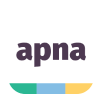

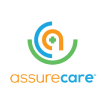

.png)
.png)
.png)



Leave a Comment